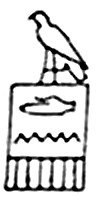| Hand (also, letter "d") in hieroglyphs | ||
|---|---|---|
| Hand version 2 in hieroglyphs | ||
|---|---|---|
| Hand version 3 in hieroglyphs | ||
|---|---|---|
In ancient Egyptian hieroglyphs, the hand symbol represented the phoneme /d/, and was also used as a determinative for actions performed as if with the hands.
